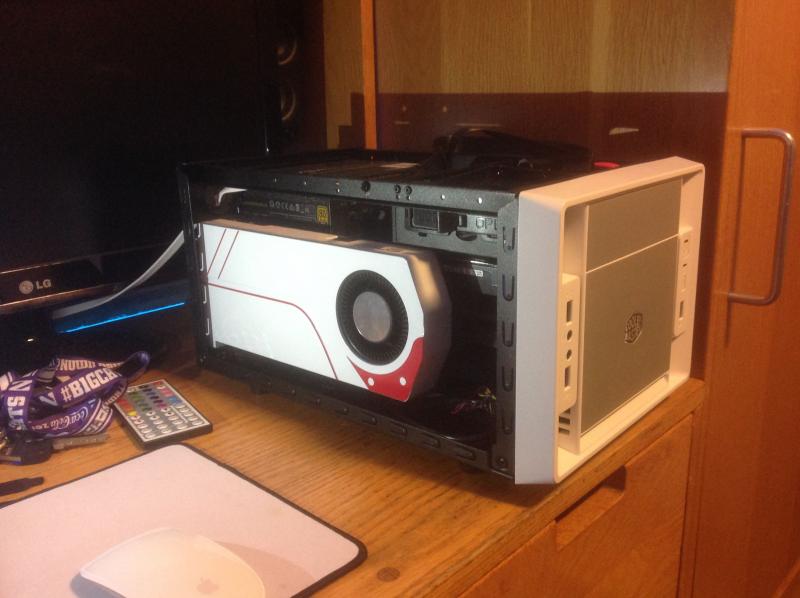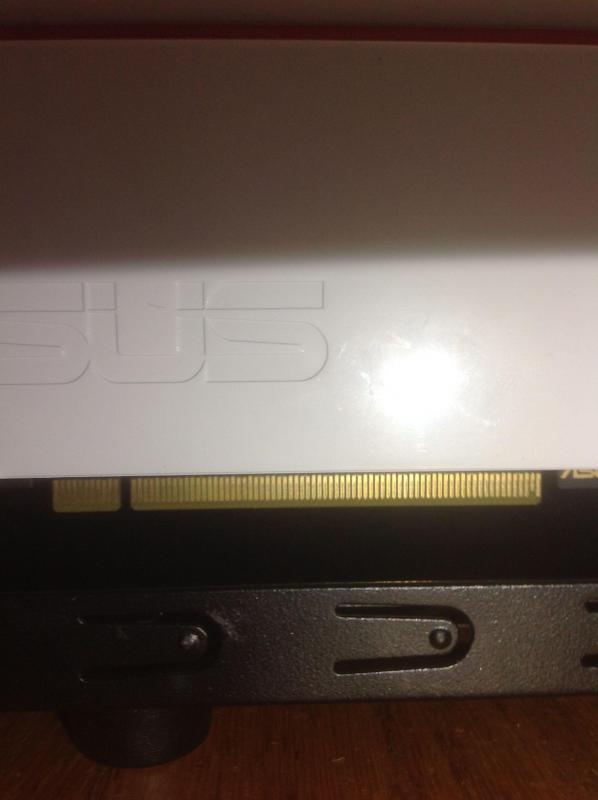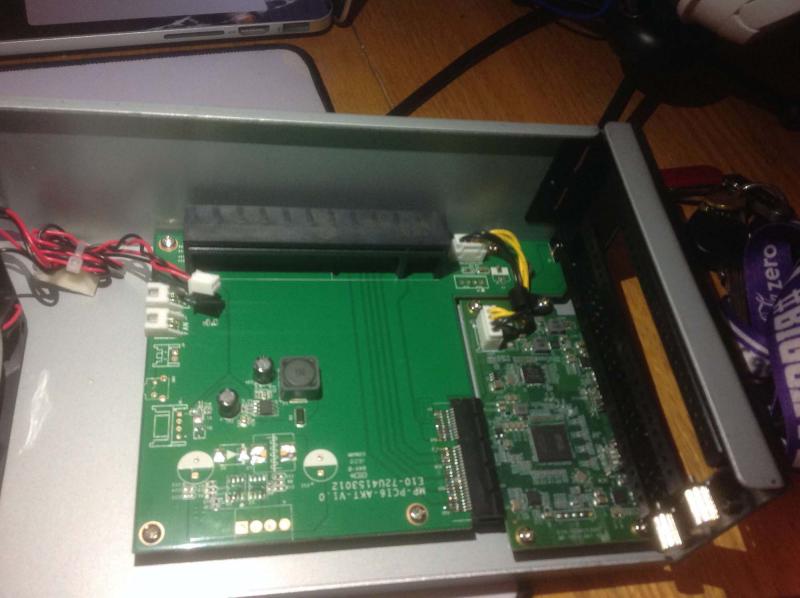Search the Community
Showing results for tags 'pcie'.
-
While searching for the solution to my various problems I began wondering if there were any other motherboards that will fit into my gt70 case (or any another msi case for that matter) What are the physical differences between the various models of msi motherboards and how many are swappable/compatible? Is an msi Frankenstein possible?
- 16 replies
-
- msi
- motherboard
- (and 6 more)
-
So i have my adapter connected to the mini pci-e of the laptop. I everything boots up just fine and i can do normal tasks. But whenever i open a game the graphics card still runs but the screen turns off. I can still hear the music from the game from the laptop's speakers, but somehow the game crashes and i have to hard reset the laptop to get video signal again. What might be causing this? I would appreciate any help and thanks in advance My setup is: Dell latitude e6330. Core i5 3380m 8gb ddr3. 2 dimms. EXP GDC v8, mini pcie. Zotac GTX 650 ti. Corsair CX500 psu. Bios A18 (lastest for my dell)
- 3 replies
-
- egpu
- dell latitude e6330
-
(and 6 more)
Tagged with:
-
Does anyone know if the T530 or T430 run a 1x Pci-e 3.0 link when an ExpressCard eGPU solution is used (like the PE4C V3.0 is used?) Or does it still run at 2.0 speeds? There should be 16x 3.0 lanes available on the CPU dies of Ivy Bridge mobile processors as they are just the desktop processors, but I am not sure if Lenovo wired the ExpressCard slot to this or the slower 2.0 lanes provided by the chipset.
-
Published on Dec 6, 2016 I have seen a lot of people online lately asking questions and wondering if it is possible to have an external graphics setup via thunderbolt for an HP Spectre (Product name:HP Spectre Notebook Product number: W2K28UA#ABA). In general, i want to show an eGPU setup via any thunderbolt 3 connection. In this video i will show how to successfully setup and run an eGPU with 3 main components. Keep in mind that if you are going to use the Akitio PCIe thunderbolt 3 expansion box like i did, you WILL NOT be able to fit full length graphics cards, they must be half length and up to full height double width. Akitio Thunderbolt 3 PCIe expansion box: (around $260) --- https://www.amazon.com/gp/product/B01... EVGA NVIDIA GeForce GTX 950 Graphics Card: (actually around $200 - i said $300 in the video so thats a plus) --- https://www.amazon.com/EVGA-GeForce-C... Power Supply EVGA 430 w: (around $25) --- https://www.amazon.com/EVGA-WHITE-War... Also, here is a link below to download the Geforce Experience for driver installation and updates. --- http://www.geforce.com/geforce-experi... Grand total, just shy of around 500 bucks give or take shipping costs. A bit steep considering that the majority is spent on the expansion box however, it is good to have the freedom to expand upon mobile hardware. Its also important to note that when i clocked the stock GPU it barely ran on the same program. it scored a mere 2400 as compared to the eGPU setup which scored over 9000, equating to roughly a 450% increase in raw graphics capability. If you have any questions please ask away.
-
UPDATE: It is now available on Amazon. https://amzn.com/B01K5Z13I2 Hi guys, Just wanted to share this with you guys! If yall been waiting for a Thunderbolt 3 version. https://www.akitio.com/press-releases/2016/akitio-unveils-thunder3-pcie-box MSRP $299.99 Available sometime this month.
- 11 replies
-
- akitio
- thunderbolt
-
(and 4 more)
Tagged with:
-
Hello everyone! I am currently working on an egpu/docking station project for my 2015 macbook pro, and I am having some issues mounting everything into the case I've chosen. So far, I have gotten it to work with my windows 10 installation (on an external samsung evo ssd inside the mini-itx case) with my gtx 970, but now I am trying to actually mount the akitio thunder2 board and the graphics card inside a mini itx enclosure. The power supply, hard drives, and usb hub are already mounted inside of the case with plenty of room left. The graphics card has to mount in the slot that it would use if there was a mini itx motherboard in the case, because it won't fit anywhere else. Here are my problems: If you look at the first attached image, this is the graphics card mounted where it would go normally. It is currently only being held in by the two screws holding the IO side of the card onto the case. As you can see in image 2, the pcie connector is underneath the card and very close to the bottom of the case. I bought a pcie riser, but having it being under the card and bent to the side put it under too much stress, and the cable tore. It also pushed the graphics card up so that it was just barely able to mount in place. What I decided I needed was a right-angle for the pcie connection, but every one I found online, and I mean EVERY ONE, went the wrong way (left instead of right) , which put the connecter against the wall of the case, making it worse. Can someone help me find a right angle adapter that bends the correct way, or find another solution? I accidentally bought this: https://www.amazon.com/gp/product/B007Q92R7M/ref=oh_aui_detailpage_o01_s01?ie=UTF8&psc=1 but it was not the pcie connector on my graphics card. It was a little different. Another problem is that the akitio thunder2 board has issues with facing the right way. If you look in picture 3, you can see the board in its enclosure. In order for the pcie connector to be oriented the same as the graphics card, the board has to be mounted so that the black plastic pcie connector is closest to the graphics card, and unfortunately, facing away. Also, the thunderbolt ports and power port end up smushed against the wall of the case, or close to it? Again, how can I fix this? I was so excited to get this project working and am now having a headache trying to make it all fit together! This community has been absolutely excellent in helping me get my egpu working, and I cannot thank those that have taken the time to make guides enough. Thanks in advance to anyone who has any ideas how to get this mess together. -Hunter
- 4 replies
-
- egpu macbook pro mac
- egpu
-
(and 12 more)
Tagged with:
-
ExpressCard FAQ for ExpressCard 34 and ExpressCard 54 Contents What is ExpressCard? Differences between ExpressCard and PC Card Is ExpressCard backward compatible with PCMCIA PC Cards? Is PCMCIA PC Card forward compatible with ExpressCard? ExpressCard Dimensions ExpressCard Slotting Is there a way to stabilize ExpressCard/34 inside ExpressCard/54 slots? How does ExpressCard 2.0 differ from ExpressCard? ExpressCard versus PC Card Overview Is it possible to add ExpressCard slots to computers with PCIe? Are any hot-swap capable external solutions for SxS ExpressCards? Are any Thunderbolt solutions for ExpressCards? What is ExpressCard? ExpressCard is PCMCIA's (subsumed by the USB-IF) portable, removable, expansion technology to replace PC Card and PC CardBus (sometimes mistakenly called PCMCIA Cards). ExpressCard holds several advantages over PC Card some of which are enumerated below. Differences between ExpressCard and PC Card ExpressCard features new interconnect technology ExpressCard utilizes two interconnect technologies, the most important of which is PCI Express (PCIe). ExpressCards featuring PCIe 1X technology are capable of 2.5Gb/s per direction, giving an ExpressCard operating in full duplex mode an approximate throughput of 250MB/s x 2, or 500MB/s of throughput, nearly quadrupling the effective speed of 32-bit PC CardBus. ExpressCard alternatively utilizes USB 2.0 for lower speed and less complex applications, with a maximum throughput of 480mb/s. ExpressCard allows for much more bandwidth ExpressCards featuring PCIe 1X technology are capable of 2.5Gb/s per direction, allowing for realization of applications, especially host adapters, that underperformed or were impossible under PC CardBus. Examples of full throughput host adapters that bottlenecked CardBus, but don't tax ExpressCard at all are FireWire 800 (IEEE 1394.b) and Gigabit Ethernet (GbE). Additionally, ExpressCard will be able to handle the latest SATAe and other high end buses with relative ease. ExpressCard has superior power saving and management ExpressCard operates at lower voltages than PC Card with 1.5 and 3.3V baselines. This allows systems deploying ExpressCard technology to take full advantage of current low power utilization throughout. ExpressCard is a serial rather than a parallel bus ExpressCard follows the trend of PCI Express and SATA in transitioning from parallel buses to serial buses. Rather than a 68-pin parallel connection used in PC Card, ExpressCard utilizes a 26-pin beam on blade serial connection. ExpressCard's use of high performance PCIe and USB 2.0 serial connections already built on to host system reduces complexity and eliminates the problems with signal timing associated with parallel buses. ExpressCard is simpler and cheaper to implement than PC Card Because ExpressCard harnesses buses that already exist on a host system, it doesn't require a separate ASIC to integrate it to a host system. Unlike PC CardBus and PC Card in which a controller chip was necessary to bridge between the card slot and the underlying system bus, ExpressCard devices literarily plug into either the PCIe or USB 2.0 bus on the system, depending on the ExpressCard type employed. ExpressCard saves in both cost and complexity in this regard. Is ExpressCard backward compatible with PCMCIA PC Cards? Our ExpressCard 34 to PCMCIA PC CardBus 16/32-bit Read-Writer Express2PCC allows computers with ExpressCard slots to use either 16-bit legacy PC Cards or 32-bit PC cardbus Cards. Express2PCC works with host systems featuring native ExpressCard 34 or ExpressCard 54 slots, or an installed PCIe to ExpressCard adapter. If the host operating system supports the PCMCIA PC Card, it should also work in conjunction with the Express2PCC. Sonnet's Qio device provides support for Panasonic P2 PC Card Memory devices on both Mac OS X and Windows. The Qio is available with either ExpressCard, PCIe, or Thunderbolt connections to the host system. Is PCMCIA PC Card forward compatible with ExpressCard? For PCIe based ExpressCards — in a word, no. However, it is useful to explain why this is the case. 32-bit PC Card CardBus card don't provide enough bandwidth to emulate ExpressCard. Furthermore, ExpressCard cards are completely different from PC Cards in voltages, form factor, physical connectivity and bus technology. USB Mode ExpressCard Only Devices While the PCMCIA ExpressCard specification requires all host adapters and slots to support both PCIe and USB 2.0 portions of the ExpressCard bus, several products are now on the market that only support the USB 2.0 mode. While this technically breaks the specification, many consumers have been clamoring for such a device. In response to such demand, products are now appearing on the market that bridge between PCMCIA PC Card and USB 2.0 based ExpressCards. Several new devices behave like USB 2.0 hubs, routing an ExpressCard's USB 2.0 through a PCMCIA PC Card slot. PCMCIA PC Card to USB 2.0-Mode ExpressCard adapters are available as 32-bit and 16-bit PCMCIA PC Card varieties. PC Card USB 2.0 mode ExpressCard host adapters cannot work with any PCIe based ExpressCards. This is true for USB to USB 2.0-Mode ExpressCard adapters like our MicroU2E series as well. ExpressCard Dimensions ExpressCards come in two form factors: ExpressCard 34 and ExpressCard 54. The form factors share the same dimensions except for width, from which the names of the form factors are derived. ExpressCard share a length of 75mm and a depth (or thickness) of 5.0mm — the same depth as Type II PC Cards. Both the widths and shapes of the two ExpressCard form factors are different, but the portion of the card which connects to the card slot are an identical 34mm. ExpressCard 34 cards are 34mm wide and rectangular in shape. ExpressCard 54 Cards are 54mm wide at their widest point and 34mm wide at the connection point, creating a shape often referred to as a "Fat-L". Either form factor is allowed additional volume extending outside of what would be considered the flush portion of an inserted card. This is referred to as the extended portion of the card and ExpressCards with such a configuration are referred to as extended cards. The extended portion can exceed the card dimension in any axis, but there are obvious practical limitations to how much. For an excellent example of an ExpressCard with an extended portion on two axis (depth and width) see: ExpressCard 34 to CompactFlash Memory Card Adapter. For an explanation of how ExpressCard modules are used in the two types of ExpressCard slots, please see ExpressCard Slotting. ExpressCard Slotting ExpressCard slots come in two varieties; those designed for both ExpressCard 54 and 34 cards, and those for ExpressCard 34 cards only. ExpressCard slots are required to provide both PCIe and USB 2.0 functionality, regardless of their size. ExpressCard 54 slots, as pictured in figures A and B on the right, are able to accept both 54 and 34 cards. What PCMCIA describes as a "novel guidance device," which seen in the lower left corner of figures A and B, physically guides an ExpressCard 34 device to the connector part of the slot. Since the connection part of the card for both types of ExpressCards is identically 34mm, this scheme provides an elegant solution for utilizing both types of cards. Conversely, only ExpressCard 34 cards fit in ExpressCard 34 slots as pictured in figure C. Paying attention to this last fact is important when shopping for ExpressCard products, if a device only has an ExpressCard 34 slot, then only shop for ExpressCard 34 devices. PCMCIA literature has expressed that systems deploying multiple ExpressCard slots should lay them out adjacently on a horizontal plane rather than the "stacked slot" convention employed by PC Card slots. Is there a way to stabilize ExpressCard/34 inside ExpressCard/54 slots? While it may have seemed a sound idea to engineers designing the original ExpressCard standard, one of the more perplexing — and troublesome — aspects of the design has been using ExpressCard/34 cards in ExpressCard/54 slots. In practice, ExpressCard/34 cards, even when properly seated, aren't stable when inserted in the larger ExpressCard slots. The gap between the card and the larger slots allowed cards to be easily dislodged or come loose. This problem is more evident when ExpressCards with large "extended card" portions, and/or with cables attached to them. When cards come loose and disconnect during operation, they drop signal, or worse, can damage the ExpressCard and even the ExpressCard slot. This is especially true for cards providing electrical current, like many Serial I/O ExpressCards. The SlotGuardExpress ExpressCard/34 Stabilizer Insert for ExpressCard/54 Slots protects against ExpressCards being dislodged from their slots. SlotGuardExpress is an inexpensive, non-conductive insert that attaches to the side of an ExpressCard/34 to eliminate the free-play between the card and the ExpressCard slot. SlotGuardExpress is available as a product for individual end users and for Original Equipment Manufacturers (OEM who want to include it with their ExpressCard/34 products. SlotGuardExpress puts an end to disrupted connections and equipment damage caused by ExpressCards moving side to side (laterally) in larger slots. Source: http://www.synchrotech.com/support/faq-expresscard.html View full article
-
- expresscard
- pc card
-
(and 6 more)
Tagged with:
-
Hello guys, First of all, really appreciate this project and I want to thank to all of you guys sharing your experience and creating such a great community. if there's anybody that managed to do it successfuly on this Thinkpad model, please PM me so I can talk with him, and I promise at the end I will post a full guide for this type of Thinkpad (wasn't able to find more that 2 posts related to this type of Thinkpad, and at one nobody responded, the second one I cannot find it anymore). I decided to start my own eGPU project, on my Lenovo Thinkpad T420s. I have waited for the PE4C-EC060A V3.0 ( eGPU PCIe x16 interface for ExpressCard) to be released and decided to order one (since Thinkpad T420s has an Express Card port) but instead I ordered an PE4C version 3.0, PCIe x16 interface for mPICe; Length 60c and it has been shipped. I than opened my laptop and I've noticed I do have a 2nd mPICe slot, and here comes my first question: 1st question: do you guys recommend me in switching to the Express Card version, or the mPICe one behaves the same as the Express Card one? The only inconvenience is that it will be harder to plug it in and out, since I take my laptop to work at a daily bases. Looking at the requirements, I saw that it is possible to do it for this type of laptop by having a bios version of 1.3x. 2nd question: The bios version of 1.3x refers to the bios versioin developed by @Tech Inferno Fan, or just the market one? ( I currently have 1.31 installed). I than need to consider what GPU to order. The post that I found about GPU installed on a Thinkpad T420s, it was talking about an Geforce GTX 570 (from what I remember - this is the post that I cannot find anymore) . I was thinking about buying an GTX 750 Ti OC2 2GB, beeing a 3rd Generation that seems to work with the PE4C V3.0, but while reading the forums, most of the guys installed a 2nd Generetion GPU. 3rd question: Does anyone know if the PE4C v3.0 Gen3 is stable or it';s safer to go with older GPUs. That's it for know. Thanks and really appreciate the support. Regards, Strack
-
Hi everyone, I'm very happy with this laptop but there is an empty M.2 slot waiting to be filled. The connector seems to offer the right pins for a PCIe x4 SSD like the SM951 but someone at Notebookreview reported that this particular model dosent work. Is it possible that NVME is the problem and other PCIe SSDs should work? Could a BIOS mod help (like inserting BIOS modules)? Can I somehow determine whether the hardware supports PCIe x4 in this M.2 port? I tried reading the PCIe configuration of the CPU with Linux, but can't interpret the result... root@ubuntu:/home/ubuntu/Desktop# bash listpcie.sh -t J6B2: x16 PCI Express J6B1: x1 PCI Express J6D1: x1 PCI Express J7B1: x1 PCI Express J8B4: x1 PCI Express root@ubuntu:/home/ubuntu/Desktop# bash listpcie.sh -l J6B2: Intel Corporation Sky Lake PCIe Controller Flags: bus master, fast devsel, latency 0, IRQ 122 Bus: primary=00, secondary=01, subordinate=01, sec-latency=0 Capabilities: [88] Subsystem: Intel Corporation Device 2015 Capabilities: [80] Power Management version 3 Capabilities: [90] MSI: Enable+ Count=1/1 Maskable- 64bit- Capabilities: [a0] Express Root Port (Slot+), MSI 00 Capabilities: [100] Virtual Channel Capabilities: [140] Root Complex Link Capabilities: [d94] #19 Kernel driver in use: pcieport J6B1: J6D1: Intel Corporation Sunrise Point-H PCI Express Root Port #5 Flags: bus master, fast devsel, latency 0, IRQ 16 Bus: primary=00, secondary=04, subordinate=04, sec-latency=0 I/O behind bridge: 0000d000-0000dfff Memory behind bridge: df300000-df3fffff Capabilities: [40] Express Root Port (Slot+), MSI 00 Capabilities: [80] MSI: Enable- Count=1/1 Maskable- 64bit- Capabilities: [90] Subsystem: Dell Device 0706 Capabilities: [a0] Power Management version 3 Capabilities: [100] Advanced Error Reporting Capabilities: [140] Access Control Services Capabilities: [220] #19 Kernel driver in use: pcieport J7B1: Intel Corporation Sunrise Point-H PCI Express Root Port #6 Flags: bus master, fast devsel, latency 0, IRQ 17 Bus: primary=00, secondary=05, subordinate=05, sec-latency=0 Memory behind bridge: df200000-df2fffff Capabilities: [40] Express Root Port (Slot+), MSI 00 Capabilities: [80] MSI: Enable- Count=1/1 Maskable- 64bit- Capabilities: [90] Subsystem: Dell Device 0706 Capabilities: [a0] Power Management version 3 Capabilities: [100] Advanced Error Reporting Capabilities: [140] Access Control Services Capabilities: [200] L1 PM Substates Capabilities: [220] #19 Kernel driver in use: pcieport J8B4: Intel Corporation Sunrise Point-H PCI Express Root Port #7 Flags: bus master, fast devsel, latency 0, IRQ 18 Bus: primary=00, secondary=06, subordinate=06, sec-latency=0 Memory behind bridge: df100000-df1fffff Capabilities: [40] Express Root Port (Slot+), MSI 00 Capabilities: [80] MSI: Enable- Count=1/1 Maskable- 64bit- Capabilities: [90] Subsystem: Dell Device 0706 Capabilities: [a0] Power Management version 3 Capabilities: [100] Advanced Error Reporting Capabilities: [140] Access Control Services Capabilities: [220] #19 Kernel driver in use: pcieport Maybe someone with a little bit more experience knows what that means.
-
Hello I recently re-installed Windows 10 after an SSD fail, which meant that I had to redo my DSDT Override. I was wondering if there was any other way of fixing error 12 than those suggested on the forum (that I know of), when I found this tool called BAR-Edit 3.2. The BAR is supposedly the PCIe memory space (unless I totally have this wrong), and I was thinking if it was possible to use this software to edit my eGPU's resources so it would work. Anyone know if this is possible? -Aerostar P.s. I didn't know where to post this, so I created a new topic (sorry if this is annoying)








